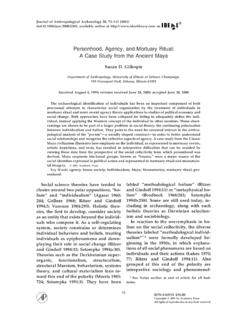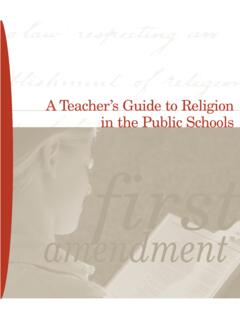Transcription of Clark Atlanta University - CLAS Users
1 Clark Atlanta Universityis collaborating with JSTOR to digitize, preserve and extend access toPhylon (1960-). Atlanta UniversityThe Evolution of Jim Crow Laws in Twentieth Century Virginia Author(s): Charles E. Wynes Source: Phylon (1960-),Vol. 28, No. 4 (4th Qtr., 1967), pp. 416-425 Published by: Clark Atlanta UniversityStable URL: : 04-12-2015 07:36 UTCYour use of the JSTOR archive indicates your acceptance of the Terms & Conditions of Use, available at info/about/ is a not-for-profit service that helps scholars, researchers, and students discover, use, and build upon a wide range of content in a trusted digital archive. We use information technology and tools to increase productivity and facilitate new forms of scholarship. For more information about JSTOR, please contact content downloaded from on Fri, 04 Dec 2015 07:36:06 UTCAll use subject to JSTOR Terms and ConditionsBy CHARLES E. WYNES The Evolution of Jim Crow Laws in Twentieth Century Virginia* TIM CROW as a state-established and state-maintained institution in Vir- ginia is a child of the twentieth century.
2 The Old Dominion, like the other Southern states, entered the new century with an absence of rigid, caste-like segregation established and maintained by state law. Not until 1900 did Virginia enact her first statewide segregation law, while as late as 1944 it was still adding to the, by then, long list of such statutes. Ironically, the greatest number, and often the most far-reaching, of these statutes was enacted not in the period 1901-1917, which might well be called that of "the nadir," but rather in the 1920's and 1930's when Negroes at long last had entered upon the road which led to the Second Reconstruction. Yet, upon closer examination, that fact is not so ironi- cal. During the period of the nadir Negroes were no threat to white Vir- ginians; for most of their race had just been disfranchised by the new state constitution of 1902, while the first of the state segregation stat- utes, and even lynching, served to keep them in their "place.
3 " But by the twenties, and especially by the thirties, once again white Southern- ers knew that their world was changing, while many of its institutions were under attack both from within and without. Not only had some of the South's segregation statutes already fallen before the federal courts, but at home Southern Negroes were attacking the constitutionali- ty of white primaries, which had made the Democratic Party a kind of "white man's club," while nationally, that same Party increasingly was coming to reflect both the interests and the philosophy of Northern urban masses. Nor was there any longer a conservative Negro leader, Booker T. Washington, to counsel his people to "put down your buck- et where you are." At such times men's thoughts turned to means by which the status quo might best be preserved, and new race laws fol- lowed. For more than thirty years following the end of the Civil War whites and Negroes, with increasing frequency, rode together in the same railroad and streetcars in Virginia.
4 Some of the railroads, at least for a while, forced Negroes to ride in the smoking car, or in a special * The resarch for this article, which is part of a larger study on Negroes in twentieth century Virginia, was supported by grants from the American Philosophical Society and the Social Science Research Council. 416 This content downloaded from on Fri, 04 Dec 2015 07:36:06 UTCAll use subject to JSTOR Terms and ConditionsJIM CROW LAWS IN TWENTIETH CENTURY VIRGINIA 417 jim crow car. But even this practice seems to have been an erratic one. As the twentieth century approached, railroad segregation became less and less frequent, so that by 1900, instead of referring to "the car where the Negroes rode," white Virginians spoke of the "present sys- tem" when they objected to mixing of the races on trains. Then suddenly in 1900, the legislature passed and Governor J. Hoge Tyler signed into law Virginia's first statute requiring the railroads to furnish separate cars, or partitioned cars, for the two Just why this was done is not wholly clear.
5 Certainly it was not done in re- sponse to any "state-wide demand," as some of the newspapers claimed. Nor is it enough to say that both this statute and the similar ones which followed were in "reaction to the bitter Populist struggles of the 1890's." Perhaps the growing respectability of racism and the legal sanctioning of separate but equal are better explanations, but race politics seems to be the most logical explanation. Not only were few whites free of racial bigotry during the Progressive era; even "gentlemen politicians" could not forego the temptation of "nigger baiting." And once such laws were enacted there were none but Negroes to work, futilely, for their repeal. Booker T. Washington, in an essay published just after his death in 1915, aptly summed up both the role of the politicians and that of the fearful whites: In all my experience I have never yet found a case where the masses of the people of any given city were interested in the matter of segregation of white and colored people; that is there has been no spontaneous demand for segregation ordinances.
6 In certain cities politicians have taken the leadership in introducing such seg- regation ordinances into city councils, and after making an appeal to racial prejudices have succeeded in securing a backing for ordi- nances which would segregate the negro people from their white fel- low citizens. After such ordinances have been introduced it is always difficult, in the present state of opinion in the South, to have any considerable body of white people oppose them, because their atti- tude is likely to be misrepresented as favoring negroes against white people. They are, in the main, afraid of the stigma, "negro lover." 2 Substitution of "state" for "city," of "legislatures" for "city councils" and of "statutes" for "ordinances" makes this observation equally valid in the explanation of the action of the Virginia General Assembly and the Governor in 1900. With the door to rigid, state-sponsored segregation opened, the politicians could not resist the temptation to keep going through it, nor could the people find either the desire or the courage to stop them.
7 1 June Purcell Guild, Black Laws of Virginia: A Summary of the Legislative Acts of Virginia Concerning Negroes from Earliest Times to the Present (Richmond, 1936), pp. 144-45. For the detailed story of the history of railroad and streetcar segregation in Virginia from the end of the Civil War to 1900, see Charles E. Wynes, Race Relations in Virginia, 1870-1902 (Char- lottesville, 1961), pp. 68-76. For the South in general, see C. Vann Woodward, The Strange Career of Jim Crow (2nd Rev. Ed., New York, 1966), pp. 36-41, 67-68. 2 Booker T. Washington, "My View of the Segregation Laws," The New Republic, V (December 4, 1915), 113-14. This content downloaded from on Fri, 04 Dec 2015 07:36:06 UTCAll use subject to JSTOR Terms and ConditionsFour years later, in 1904, segregation on the railroads was further tightened when a new law authorized railroad operators to refuse ad- mittance of any colored person to the dining, Pullman, parlor, chair, or compartment In 1902 segregation on streetcars running between Richmond and Seven Pines in nearby Henrico County was provided for, while in 1906 the law was broadened to cover all streetcars operating in the Of course, on streetcars as later on buses, this meant setting aside a portion of the vehicle for use by Negroes.
8 Still, a jim crow seat one day might be occupied by whites and the next, depending upon the number, by Negro or white passengers. Naturally indignation and unpleasantries, as well as ugly and em- barrassing scenes, followed as curtains were drawn about Negro pas- sengers on the trains, while on the streetcars a member of one race - usually the Negro - was told by the conductor to move from a seat be- cause it "belonged" to the other race. There is every reason for believing that the new segregation laws added to friction between the races. Now, both disfranchised and segregated on the railroads and street- cars (as well as steamboats, since 1900), Virginia Negroes were not fur- ther segregated by law until 1912, when residential segregation was pro- vided for. The residential segregation law empowered cities and towns to designate districts as "white" or "colored," on the basis of whether 50 percent of the inhabitants were white or Negro.
9 While one could not be forced to move out of a district designated for the opposite race, beginning twelve months after such designation, persons of the opposite race were forbidden to move into the district. Violators might be fined from five to fifty dollars, plus an additional two dollars for each day they As early as 1917 in a Kentucky case, Buchanan v. Warley, the United States Supreme Court declared such residential segregation laws to be unconstitutional, and in 1918 Virginia's own Supreme Court of Appeals threw out a Clifton Forge ordinance (Irvine v. City of Clifton Forge). Twice more, in 1928 and 1930, the United States Supreme Court condemned similar laws, yet not till 1950 was the statute left out of the Code of Virginia. Politically, of course, the least important people in any state are those in prison, yet not till 1918 did Virginia prescribe by law that the races be kept separate in the State Two years later, in 1920, the Board of Directors of the Penitentiary ordered the prison super- intendent and the superintendent of the state farm to see that the races were separated "as far as practicable.
10 " It is not clear just how much 8 Guild, op. cit., p. 147. Ibid; Pauli Murray (ed.), States' Laws on Race and Color, and Appendices Containing Inter- national Documents, Federal Laws and Regulations, Local Ordinances and Charts (Cincinnati, 1951), p. 484. Guild, op. cit., pp. 147-48. 6 Ibid., p. 148. 418 PHYLON This content downloaded from on Fri, 04 Dec 2015 07:36:06 UTCAll use subject to JSTOR Terms and ConditionsJIM CROW LAWS IN TWENTIETH CENTURY VIRGINIA 419 segregation or integration had existed before the order was issued, but the Board of Directors admitted that the new instructions were issued be- cause it was "found that proper separation of the races was [theretofore] not enforced." It is certain, however, that the order led to separate dining halls for the first When further segregation laws came in the decade of the 1920's, they seem to have come largely in response to the demands of a small but powerful pressure group - the Anglo-Saxon Clubs.


















